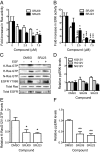Andrographolide derivatives inhibit guanine nucleotide exchange and abrogate oncogenic Ras function
- PMID: 23737504
- PMCID: PMC3690838
- DOI: 10.1073/pnas.1300016110
Andrographolide derivatives inhibit guanine nucleotide exchange and abrogate oncogenic Ras function
Abstract
Aberrant signaling by oncogenic mutant rat sarcoma (Ras) proteins occurs in ∼15% of all human tumors, yet direct inhibition of Ras by small molecules has remained elusive. Recently, several small-molecule ligands have been discovered that directly bind Ras and inhibit its function by interfering with exchange factor binding. However, it is unclear whether, or how, these ligands could lead to drugs that act against constitutively active oncogenic mutant Ras. Using a dynamics-based pocket identification scheme, ensemble docking, and innovative cell-based assays, here we show that andrographolide (AGP)--a bicyclic diterpenoid lactone isolated from Andrographis paniculata--and its benzylidene derivatives bind to transient pockets on Kirsten-Ras (K-Ras) and inhibit GDP-GTP exchange. As expected for inhibitors of exchange factor binding, AGP derivatives reduced GTP loading of wild-type K-Ras in response to acute EGF stimulation with a concomitant reduction in MAPK activation. Remarkably, however, prolonged treatment with AGP derivatives also reduced GTP loading of, and signal transmission by, oncogenic mutant K-RasG12V. In sum, the combined analysis of our computational and cell biology results show that AGP derivatives directly bind Ras, block GDP-GTP exchange, and inhibit both wild-type and oncogenic K-Ras signaling. Importantly, our findings not only show that nucleotide exchange factors are required for oncogenic Ras signaling but also demonstrate that inhibiting nucleotide exchange is a valid approach to abrogating the function of oncogenic mutant Ras.
Keywords: allosteric site; cancer; drug design; molecular dynamics.
Conflict of interest statement
The authors declare no conflict of interest.
Figures





References
-
- Malumbres M, Barbacid M. Cell cycle, CDKs and cancer: A changing paradigm. Nat Rev Cancer. 2009;9(3):153–166. - PubMed
-
- Scheffzek K, et al. The Ras-RasGAP complex: Structural basis for GTPase activation and its loss in oncogenic Ras mutants. Science. 1997;277(5324):333–338. - PubMed
-
- McCormick F, Wittinghofer A. Interactions between Ras proteins and their effectors. Curr Opin Biotechnol. 1996;7(4):449–456. - PubMed
-
- Wang W, Fang G, Rudolph J. Ras inhibition via direct Ras binding—Is there a path forward? Bioorg Med Chem Lett. 2012;22(18):5766–5776. - PubMed
Publication types
MeSH terms
Substances
Grants and funding
LinkOut - more resources
Full Text Sources
Other Literature Sources
Research Materials
Miscellaneous

